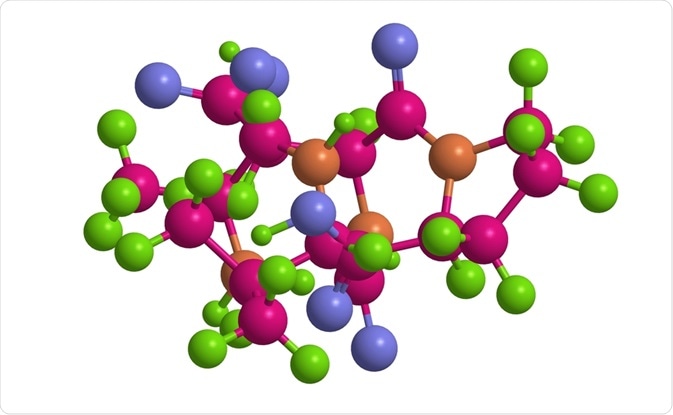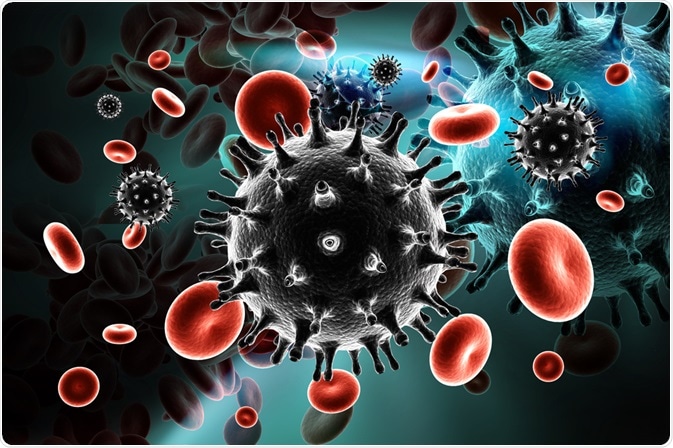Peptides are of particular interest as therapeutic drugs because the body naturally produces many different peptides, this means they are relatively well-tolerated as therapeutics and have fewer side-effects.

Image Credit: Raimundo79/Shutterstock.com
Peptides are short chains of amino acids linked by a peptide bond, they perform many roles within the cell including signaling and anti-infectives. The suitability of the peptide for therapeutic use depends on the sequence, whether it based on those peptides that are naturally produced by the body, similar to those naturally produced or a sequence novel to the body. Each source of peptide has its own advantages and drawbacks.
What is a Peptide?
Peptides, polypeptides, and proteins are all chains of amino acids linked via peptide bonds. The distinction between these peptides, polypeptides, and proteins is not well defined but is based on length. Peptides are short chains of amino acids whereas polypeptides and proteins are long chains.
The peptides currently being tested as therapeutics are under 40 amino acids in length, while polypeptides can be over 100 amino acids long and proteins are made up of one or more of these polypeptide chains.
The properties of a peptide depend on which of the 21 the amino acids that they are composed of, with the properties of the amino acid side chains affecting their conformation, thus function, and role within the body.
Therapeutic Potential
The majority of naturally occurring peptides bind to cell surface receptors triggering intracellular responses. With over 7000 peptides that occur naturally in the body, this represents a wide pool of peptides and functions to work with.
Naturally occurring peptides have many different functions from hormones, growth factors, neurotransmitters, ion channel ligands, and anti-infectives. Therefore, the use of peptides as therapeutics provides a method of targeting a wide range of cells and manipulating their response.
If these therapeutics are based on known peptides, they are relatively safe and well-tolerated because there are bodily processes that maintain peptide levels. Three different types of peptide are used in therapeutics, native, analog, and heterologous.
Native Peptides
These are peptides are based on naturally occurring peptides produced by the body. The advantage of native peptides is toleration and natural control mechanisms that reduce negative side effects. However, this leads to a major issue with native peptides, short half-lives.
The blood contains many peptidases that break down the molecule, clearing the peptide out of the blood thus maintaining homeostasis. Another issue is drug administration. If taken orally, the peptides are exposed to the digestive process which contains many peptidases that break down the peptides before they enter the bloodstream.
Therefore, many native peptides are administered through injection, but this is not the most desirable method of administration as it reduces patient compliance. Another method is adapting the native peptides, increasing their resistance to digestive enzymes, thus creating analog peptides.
Analog Peptides
Analog peptides are based on native peptides, but the sequence is adapted to improve the therapeutic potential of the peptide. This can be achieved through a modification to the amino acid sequence or through conjugation with other molecules. The improvements include an extension of the half-life, increasing the peptide’s resistance to digestive enzymes, and increasing the specificity for the intended target.
Consequently, the majority of peptides in clinical trials are analog peptides, however, these peptides do not necessarily benefit from the same control mechanisms that balance the side-effects of native peptides, therefore analog peptides have to be carefully tested.
Heterologous Peptides
The third group of therapeutic peptides is heterologous peptides. These peptides bear no relation to native sequences, they are short amino acid sequences discovered through library screening of naturally produced compounds of other species, rational and computational design, or phage display.
Without a native comparison, these peptides may have longer half-lives and novel functions, but they are more likely to have unknown side effects.
Application of Peptides to Therapeutics
There are many different prospects for the use of peptide therapeutics. The simplest is peptide replacement. Some diseases are due to the body producing a defunct peptide or not producing it at all, for instance, insulin production in diabetes, therefore simply providing the correct functioning peptide is sufficient for the treatment.
Another therapeutic use of peptides combines the selectivity of peptides with their ability to pass through the cell membranes. Conjugating peptides with cytotoxic or imaging agents allows accurate targeting of the substance towards certain cells.
Peptides even function as antivirals, with some that target HIV, flu, and hepatitis being licensed for therapeutic use. These peptides usually target the virus directly inhibiting the replication cycle.

Image Credit: RAJ CREATIONZS/Shutterstock.com
Future Prospects
Advances in protein synthesis have increased the complexity of peptides being produced for therapeutic purposes. In the 1980s all peptide therapeutics were under 10 amino acids long whereas now they are up to 40 amino acids long. Additionally, advances in bioinformatics increase the ability to construct and predict how peptides may function, speeding up the discovery of new peptide therapeutics.
Conclusion
Peptide therapeutics have the potential to be used to treat many conditions, from peptide replacement to antivirals. Native, analog, and heterologous derided peptides each have advantages but also drawbacks.
Native peptides are well tolerated but are easily broken down by the body. Whereas analog peptides can be designed to be harder to break down or bind other molecules but this makes them not as easily processed by natural machinery.
Finally, heterologous carry the highest risk of side effects but have but are the largest source of potential therapeutic peptides. Together, these peptides can perform a wide spectrum of functions leading current diverse roles in therapeutics and with the advancement of bioinformatics and protein synthesis techniques so the pool for potential peptides for therapeutic use will increase.
References
- Lau, J. L., & Dunn, M. K. (2018). Therapeutic peptides: Historical perspectives, current development trends, and future directions. Bioorganic and Medicinal Chemistry, 26(10), 2700–2707. https://doi.org/10.1016/j.bmc.2017.06.052
- D’Annessa, I., Di Leva, F. S., La Teana, A., Novellino, E., Limongelli, V., & Di Marino, D. (2020). Bioinformatics and Biosimulations as Toolbox for Peptides and Peptidomimetics Design: Where Are We? Frontiers in Molecular Biosciences, 7(May), 1–11. https://doi.org/10.3389/fmolb.2020.00066
- Derakhshankhah, H., & Jafari, S. (2018). Biomedicine & Pharmacotherapy Cell-penetrating peptides: A concise review with emphasis on biomedical applications. Biomedicine & Pharmacotherapy, 108(September), 1090–1096. https://doi.org/10.1016/j.biopha.2018.09.097
- Fosgerau, K., & Hoffmann, T. (2015). Peptide therapeutics: current status and future directions. Drug Discovery Today, 20(1), 122–128. https://doi.org/10.1016/j.drudis.2014.10.003
- Lau, J. L., & Dunn, M. K. (2018). Therapeutic peptides: Historical perspectives, current development trends, and future directions. Bioorganic and Medicinal Chemistry, 26(10), 2700–2707. https://doi.org/10.1016/j.bmc.2017.06.052
Further Reading